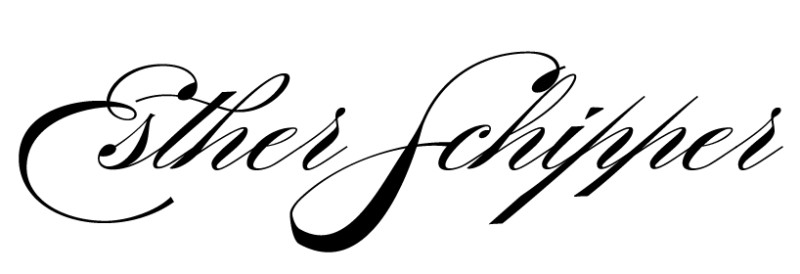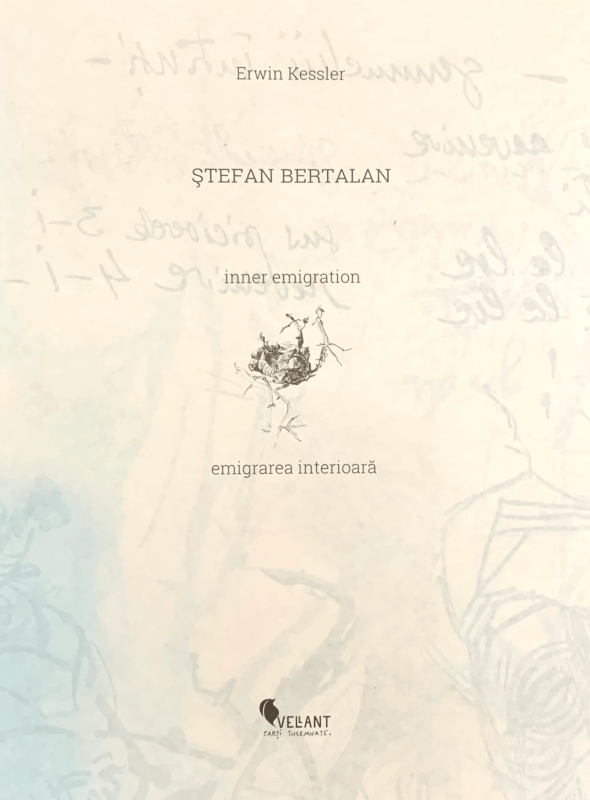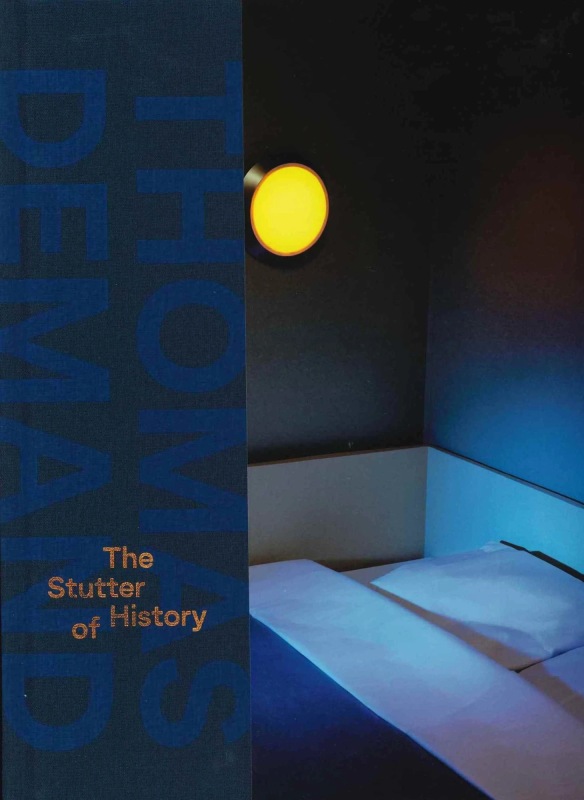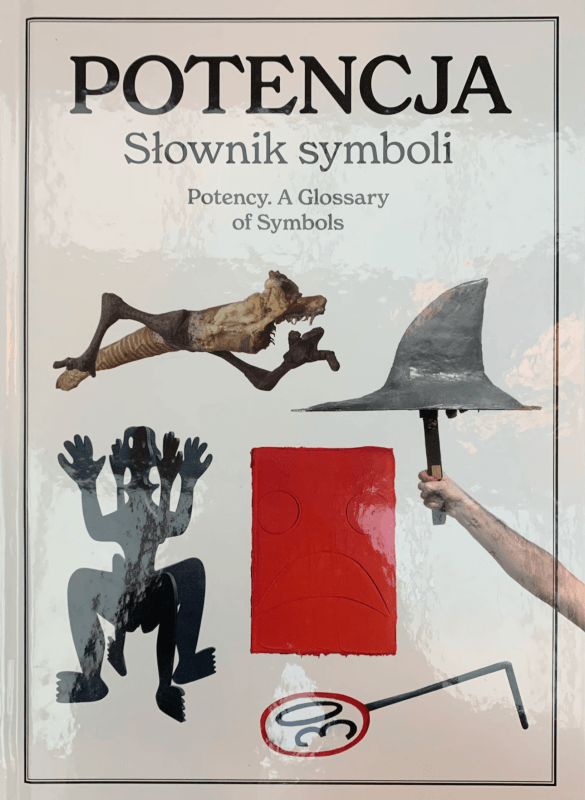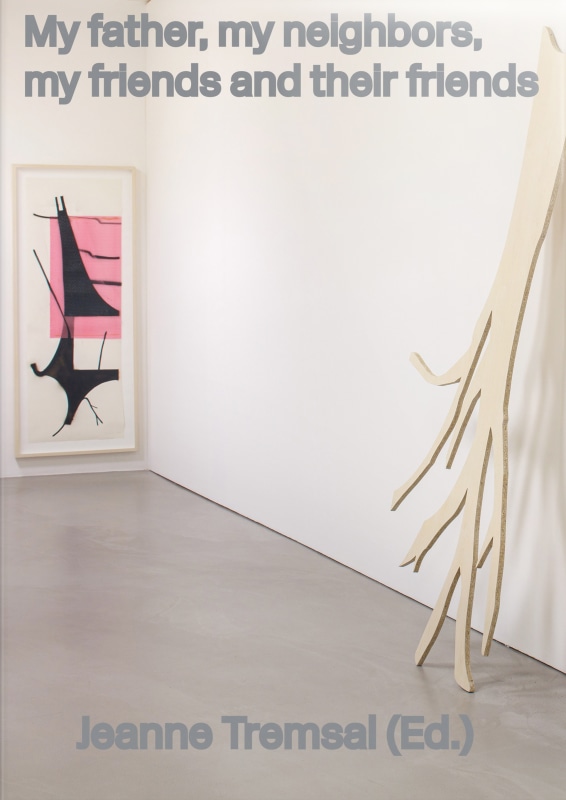Willkommen: Hier finden Sie die deutsche Fassung des Briefes aus BerlinWelcome to the Letter from Berlin! This issue begins with a look at the three exhibitions of Thomas Demand's currently on view in Paris: memo, at our Paris gallery, The Stutter of History at the Jeu de Paume, and Formes et Patrons d’Azzedine Alaïa par Thomas Demand at the Fondation Azzedine Alaïa. We pair them with recent interviews and texts. At the Berlin gallery two exciting exhibitions just opened: Ends of Research presents 50 works by the Romanian avant-garde artist Stefan Bertalan, curated by the art historian Erwin Kessler. For Reconciling Apparent Contradictions, the three young Polish painters Karolina Jabłońska, Tomasz Kręcicki and Cyryl Polaczek have turned the exhibition space into a book, installing their works on a painted background made to resemble open pages. Finally, in the bookstore a special presentation for Jeanne Tremsal's new limited-edition book includes works by her father, Benoît Tremsal, Angela Bulloch, Isa Melsheimer and Christopher Roth—and of course her book! Find publication relating to all these exhibitions in our reading corner. We hope you enjoy our Letter from Berlin!
|
|
|
Thomas Demand
memo, Esther Schipper Paris
|
|

|
Exhibition view: Thomas Demand, memo, Esther Schipper, Paris, 2023. © the artist/l'artiste / VG Bild-Kunst, Bonn, 2023. Photo © Andrea Rossetti
| |
|
Thomas Demand's exhibition at our Paris gallery includes a selection of new and recent works, executed in C-print, dye transfer and collotype. The exhibition is on view through April 1, 2023.
In one room the large-scale C-print Repository is flanked by Schilf, a collotype. Repository, 2018, imagines a small room which Alexander Kluge used as study in the 1980s. An homage to the senior German film director, tv producer and philosopher who has been a frequent interlocutor and collaborator of Demand’s for many years, Repository reconstructs Kluge’s longtime studio in Munich. Recreating a place that no longer exists, Demand constitutes a living memory of a life work: both as site of activity, for example, Kluge’s extensive interview practice, and as repository of this work stored in multiple media, tape recordings, video cassettes, reels of film, and of course books. |
|
|

| Exhibition view: Thomas Demand, memo, Esther Schipper, Paris, 2023. © the artist/l'artiste / VG Bild-Kunst, Bonn, 2023. Photo © Andrea Rossetti | |
|
The exhibition includes four works from The Dailies. As do all the works from this series, begun in 2008 and printed using the nearly extinct process of dye transfer, they picture small incidents of everyday life, based on images the artist caught on his cell phone. They recall moments of drifting attention in which our gaze is briefly arrested by an object that now catches our eye. Even with little visual information—all details carefully chosen by the artist—our imagination begins to construct a scenario for these vignettes. What looks like classic photography still-life also marks Demand’s attention to the proliferation of amateur pictures shared in social media channels, or, as the eminent art historian Hal Foster puts it: “Certainly our shared media memory is a deep subject of Demand’s work, and The Dailies also point to a mnemonic dimension buried in the trivia of our lives.”
|
|
|
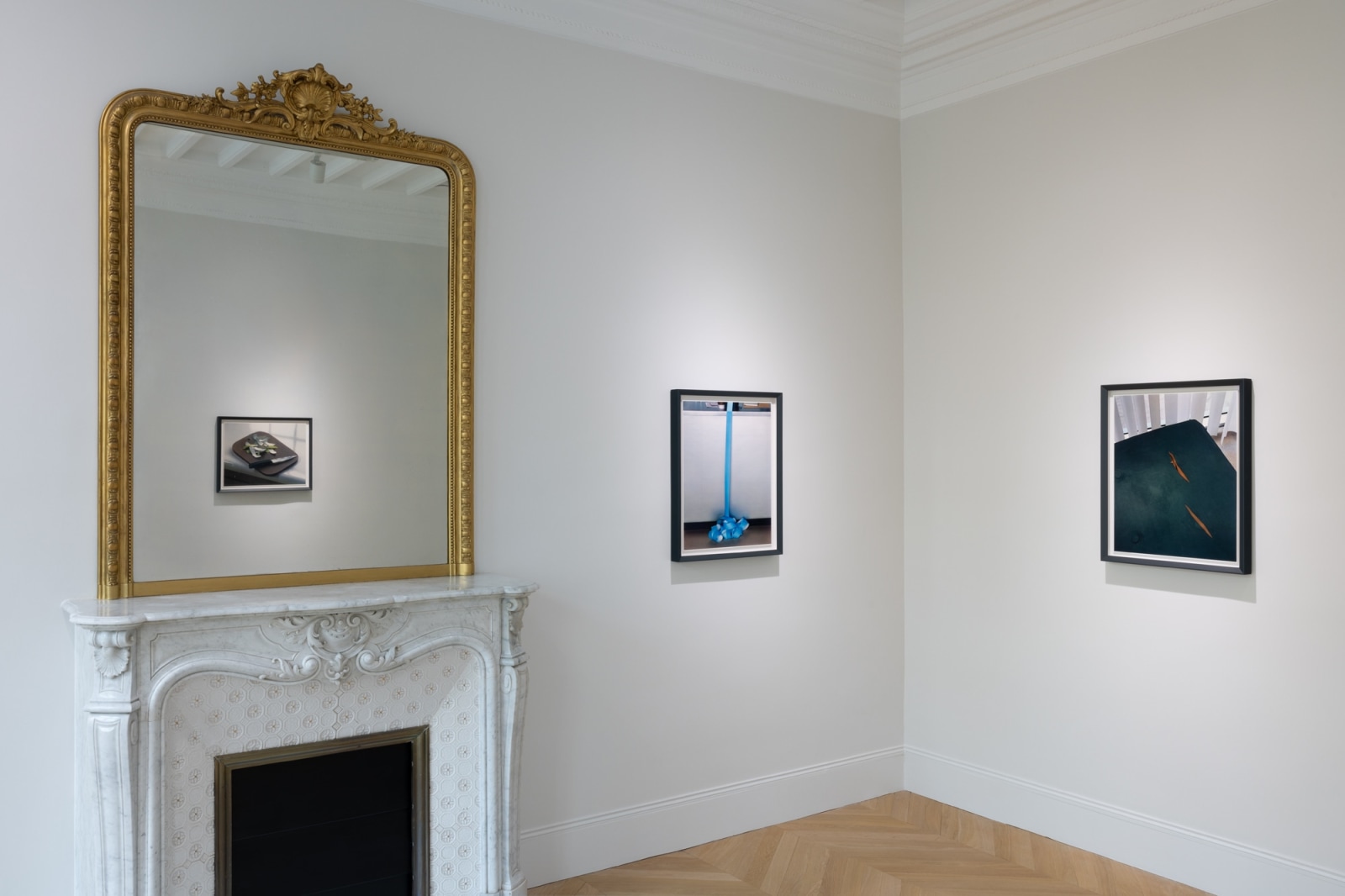
| Exhibition view: Thomas Demand, memo, Esther Schipper, Paris, 2023. © the artist/l'artiste / VG Bild-Kunst, Bonn, 2023. Photo © Andrea Rossetti | |
|
At the same time, The Dailies series evokes a rich legacy of art historical iconography. Thus Daily #31 is dominated by a green surface with two deep slashes that reveal orange padding. A scene of slight dilapidation, the image can be read as an oblique reference to the work of Lucio Fontana and his “cuts,” first produced in the late 1950s. The flattened orange of Daily #33, on the other hand, can register as abstraction, while the long paper trail depicted in Daily #35 alludes both to an absent human who might have removed the excess, and an activity. Daily #36, finally, is indebted to the tradition of still-life painting. Depicting a cutting board with a knife and leftover peel from an apple, the shimmering metal blade and the soft glow of the white windowsill recall the virtuosity of competing polished surfaces in Netherlandish vanitas paintings. Incidentally, the “consumed” or “spent” apple also represents the final work in the series of The Dailies.
|
|
|
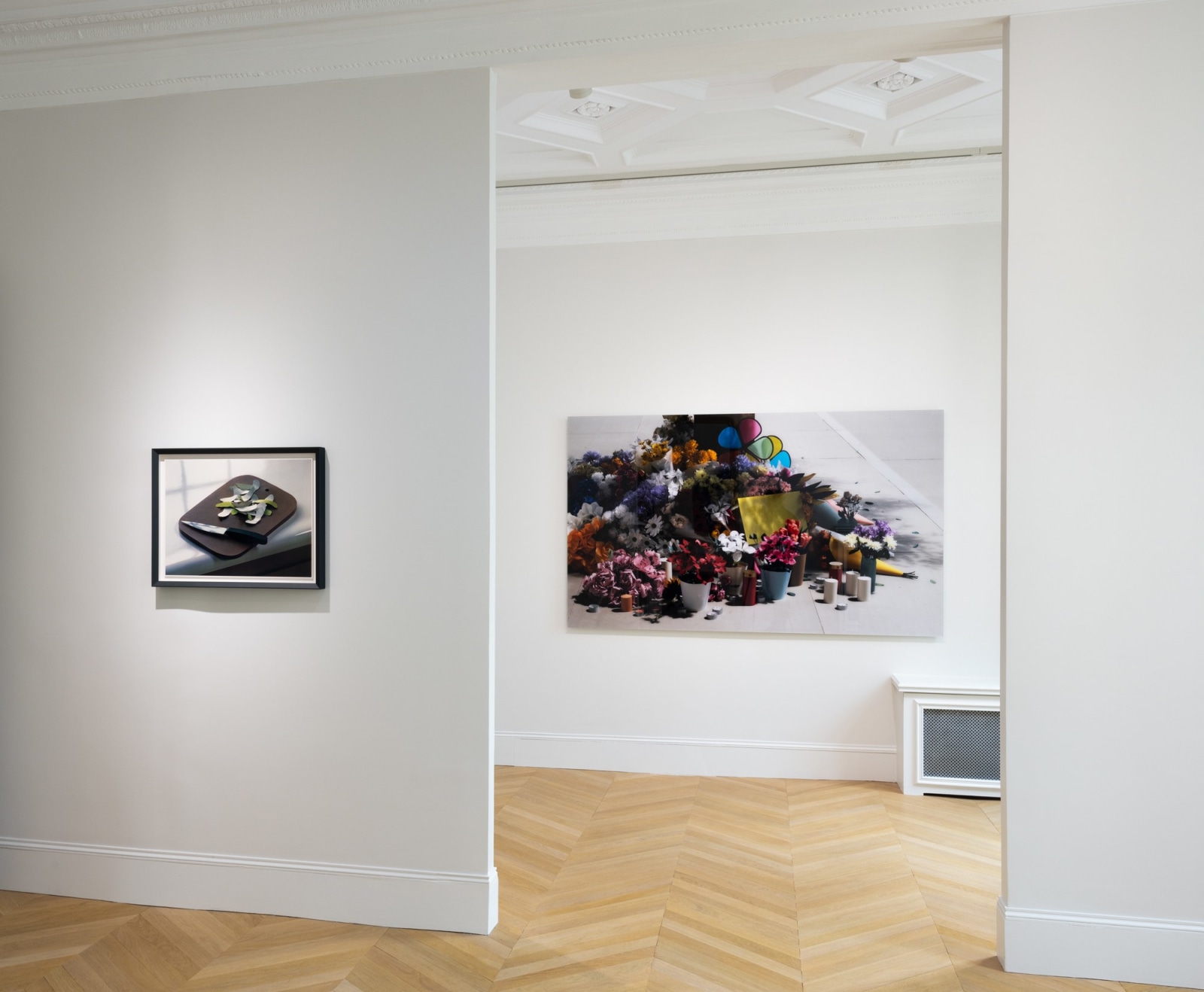
| Exhibition view: Thomas Demand, memo, Esther Schipper, Paris, 2023. © the artist/l'artiste / VG Bild-Kunst, Bonn, 2023. Photo © Andrea Rossetti | |
|
A new work, Memorial, depicts a make-shift shrine with various bunches of flowers, candles and small placards, heaped together around a tree on a sidewalk. At first sight bright and colorful, the scene has a somber subtext. A reminder of the frequent gun violence in the United States for which such ad-hoc commemorations often quickly form, it draws on images from Buffalo, NY—although the specific reference may be less relevant than the lamentable ubiquity of the imagery.
|
|
|
The Stutter of History
Jeu de Paume, Paris
|
|
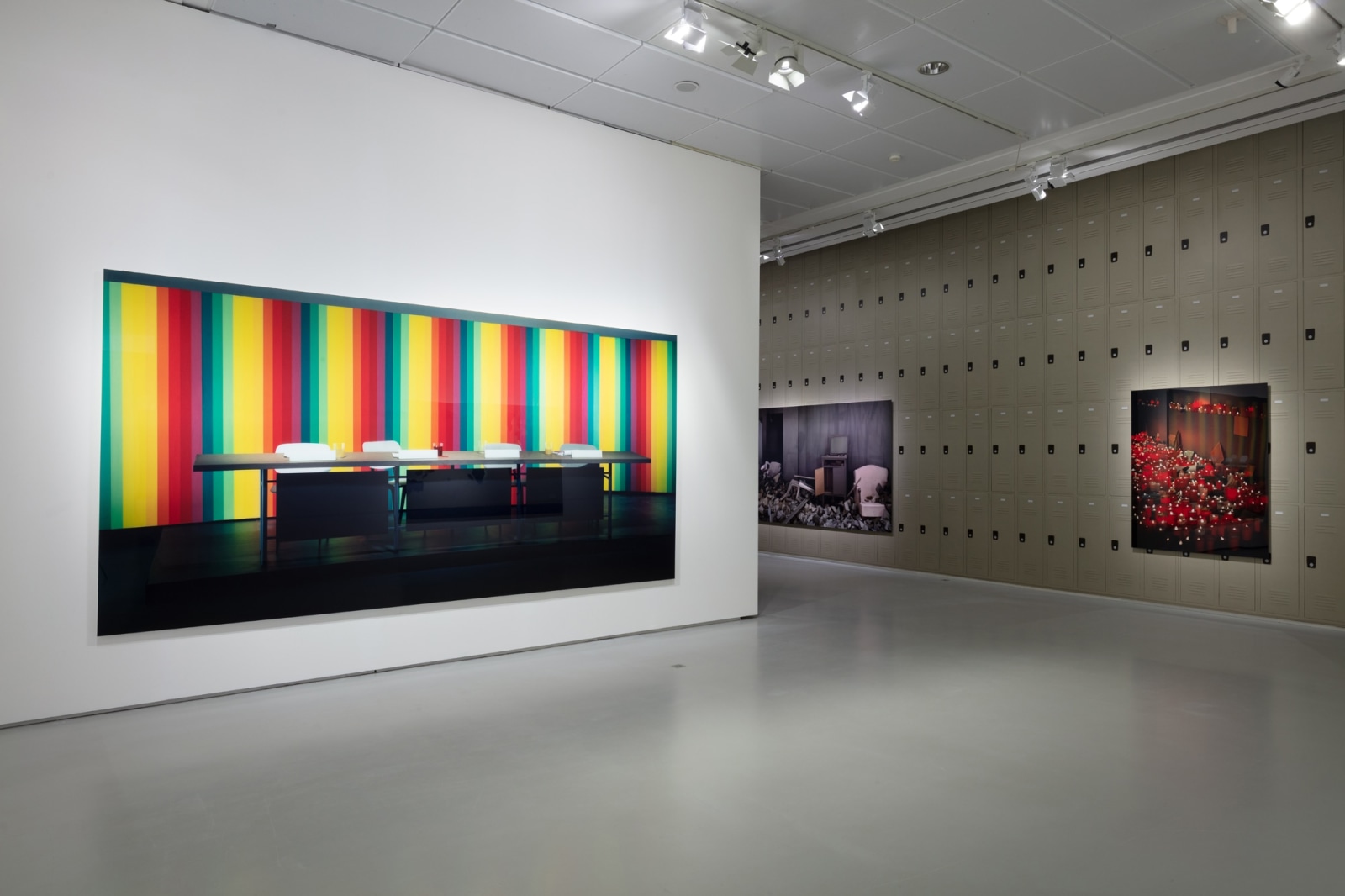
| Exhibition view: Thomas Demand, The Stutter of History, Jeu de Paume, Paris, 2023. © the artist / VG Bild-Kunst, Bonn, 2023.
Photo © Jeu de Paume / François Lauginie | |
|
The Stutter of History is the first major Thomas Demand retrospective in France, presenting about 70 works (photographs, films and wallpapers), covering the major aspects of Demand’s work.
The artist has spent the last two and a half decades bringing together his talents as both a sculptor and a photographer in an attempt to capture the uncanny stutter of history that lies at the root of our contemporary image culture. Demand’s images may appear to depict the real world but upon closer inspection they resonate with a fragile similitude that belies the fact that they are actually photographs of his handmade three-dimensional sculptural recreations of found images culled from the media.
|
|
|

| Exhibition view: Thomas Demand, The Stutter of History, Jeu de Paume, Paris, 2023. © the artist / VG Bild-Kunst, Bonn, 2023.
Photo © Jeu de Paume / François Lauginie | |
|
In a 2021 interview with the French magazine Numéro art, Thomas Demand spoke about the development of his iconography and the notion of fiction.
Numéro art: Your photographs often feature a life-size reconstruction of a crime scene, regardless of whether it’s really a crime or a political event... These photos are also often inspired by images found in the press or archives, or come from police sources. Your art revolves around the relationship between truth and truthfulness, between reliable information and falsified information. But the artwork that results from your methodology is itself an “artefact.” Why should we trust the intentions of an artist and a work of art more than an anonymous source of information?
Thomas Demand: Firstly, it’s difficult these days to know whether the original source of information, anonymous or not, is real, simply because images can now be manipulated in such a way that no one is aware of the manipulation. Secondly, I’m not interested in factual truth, I’m more interested in truthfulness in a literary sense. If a writer like Vladimir Nabokov talks about his childhood in St. Petersburg, you might be able to prove that his uncle’s name was Boris not Igor, but that won’t change the literary quality of his book. I hope the same goes for me – I don’t work with facts but with the telling of those facts, with the ability to communicate and with the proliferation of images in a societal context. For my art, I don’t need factual truth, my subject is the fictional capacity of an image to tell us something.
Numéro art: You mention a very important concept: fiction. What significance does fiction have in your art?
TD: For the last ten years or so, we have been forced to get used to the notion of the fake, to the deliberate claims of a manipulated reality or truth. The same goes for photography: its truth content is very diminished, yet we’ve learnt to live with it. Our iconography is probably different from that of 50 or 70 years ago, but we deal with it quite well. That’s what interests me as an artist. We have this ability to analyse the authenticity of each image and to verify its source.
Numéro art: How do you choose your subjects, and according to what criteria? You mentioned the societal importance, but are there also more personal connections – to your own biography for example?
TD: There are, but as an individual I’m not very interesting. So I have to find a way to eliminate everything that is autobiographical. For example, I have a photo of myself as a child, taken in my room, among my toys. What interests me in this photo is the toy as a model, our relationship with toys, their cultural significance at that time. That’s why I built a model of my childhood bedroom, which I then photographed. And then there are the Dailies, everyday impressions that I photograph while walking down the street, like a passer-by. They’re a kind of visual haiku that you can walk through.
|
|
|
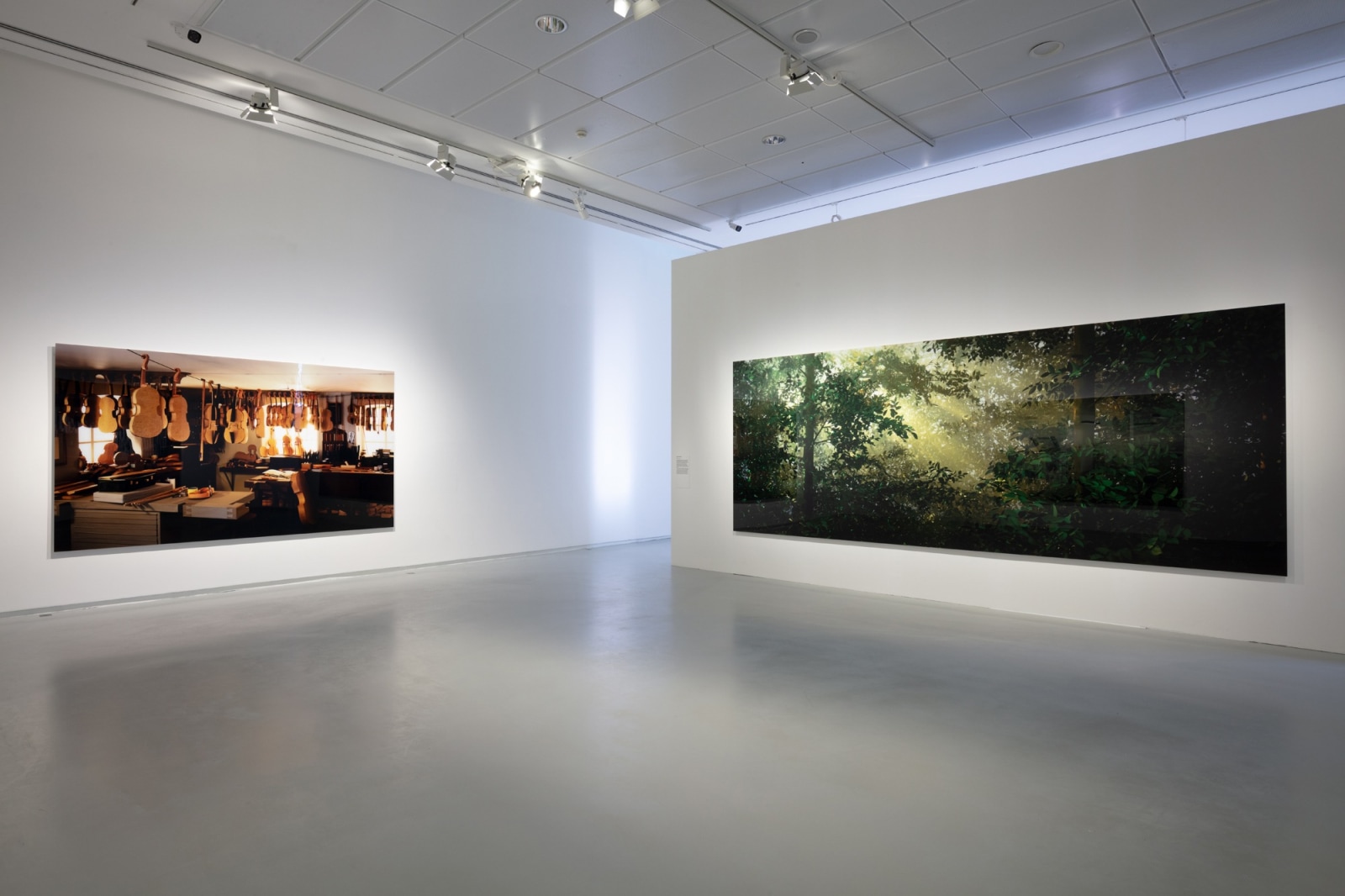
| Exhibition view: Thomas Demand, The Stutter of History, Jeu de Paume, Paris, 2023. © the artist / VG Bild-Kunst, Bonn, 2023.
Photo © Jeu de Paume / François Lauginie | |
|
In the context of another exhibition, House of Card, which traveled from M Leuven to the Museum of Contemporary Art in Toronto last year, e-flux architecture published a number of essays about the relationship of architects, and artists, to models. This excerpt is taken from Sylvia Lavin's essay "One to What? Cultural Technique and Model Making" "Although they represent architecture, are sometimes made by architects, and depend on certain conventionally architectural techniques, Demand’s models do not perform architectural work, and neither elevate nor devalue the architectural work of others. To the contrary, Demand’s architectural models are only opportunistically related to architecture and operate more fundamentally as stations within a complex network of communication signals. When he makes, photographs, and then discards them, Demand’s models perform the process through which contemporary culture wrests spatiality from the world, flattening even architecture into the dominion of circulating images. When he photographs models made by celebrated architects like John Lautner and Sanaa, the camera is focused on signs of technological artifacts, error, and decay that position the architect as merely one among a network of human and non-human agents. In other words, Demand is less affirmatively appropriating architectural model making than architects are failing to recognize his critique both of ideas about architectural representation that are no longer useful, and of architects who imagine themselves to be the central protagonists of the worlds they model. "
Sylvia Lavin, "One to What? Cultural Technique and Model Making" published in the series On Models by e-flux architecture. Read the full essay HERE.
|
|
|
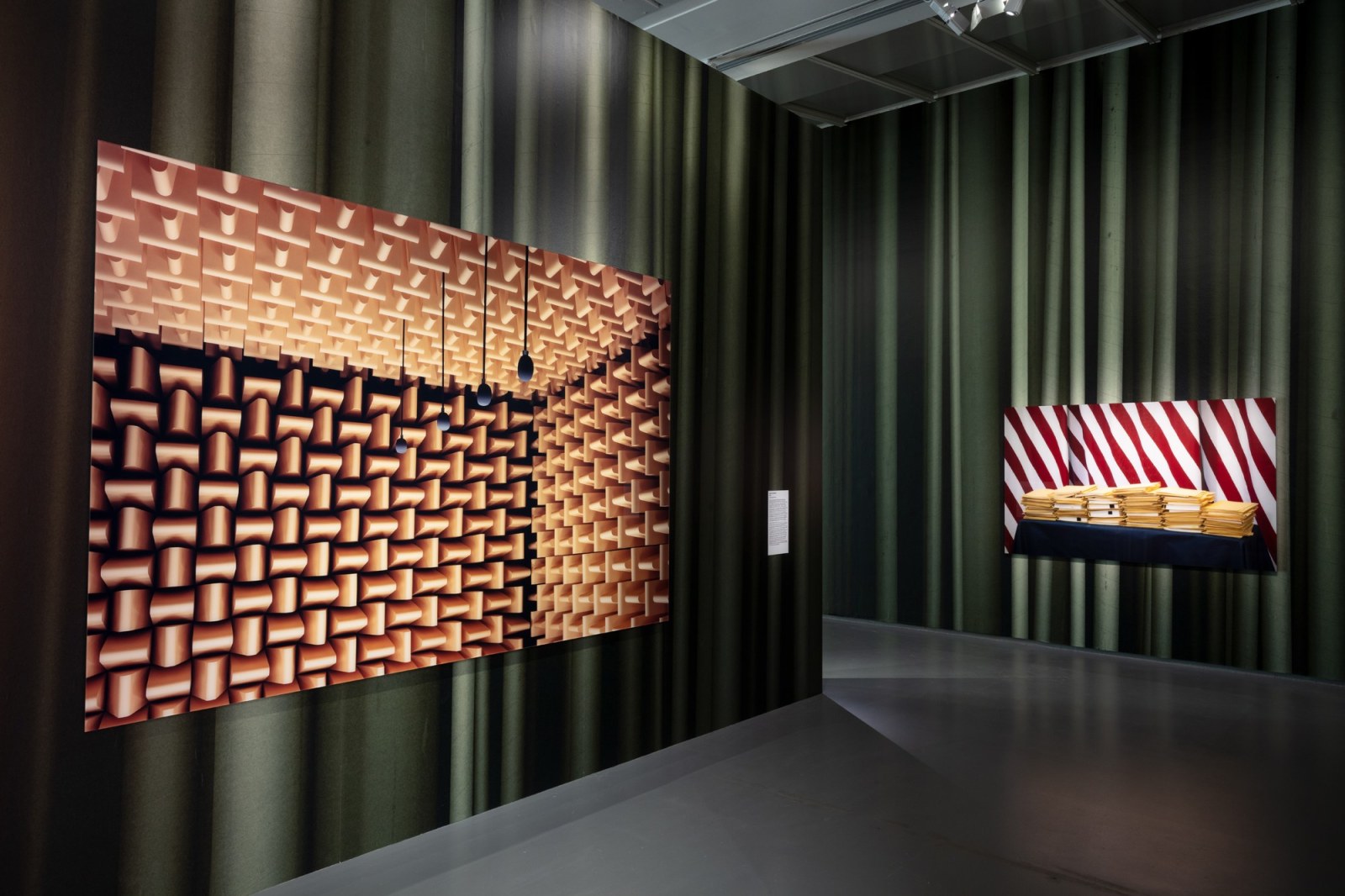
| Exhibition view: Thomas Demand, The Stutter of History, Jeu de Paume, Paris, 2023. © the artist / VG Bild-Kunst, Bonn, 2023.
Photo © Jeu de Paume / François Lauginie | |
|
Installed throughout the staircases and visible from the outside of the Jeu de Paume, is Thomas Demand's Hanami. From his series of wall paper works, Hanami shows branches with a myriad of delicate blossoms. Characteristic of Sakura, Japanese cherry blossoms, bright red sepals at the stem and pink petals frame a dark red stigma in their center. While the blossoms cover most of the image, a light blue background can be seen in some places. Hanami refers to the traditional Japanese custom of celebrating the fleetingness of life and of beauty by celebrating cherry tree blossoms during their short bloom. Trees without fruit, in this model, the Japanese cherry trees exist only for this brief display of beauty. At the same time, a sign of spring, the blossoming trees represent a new beginning. |
|
|
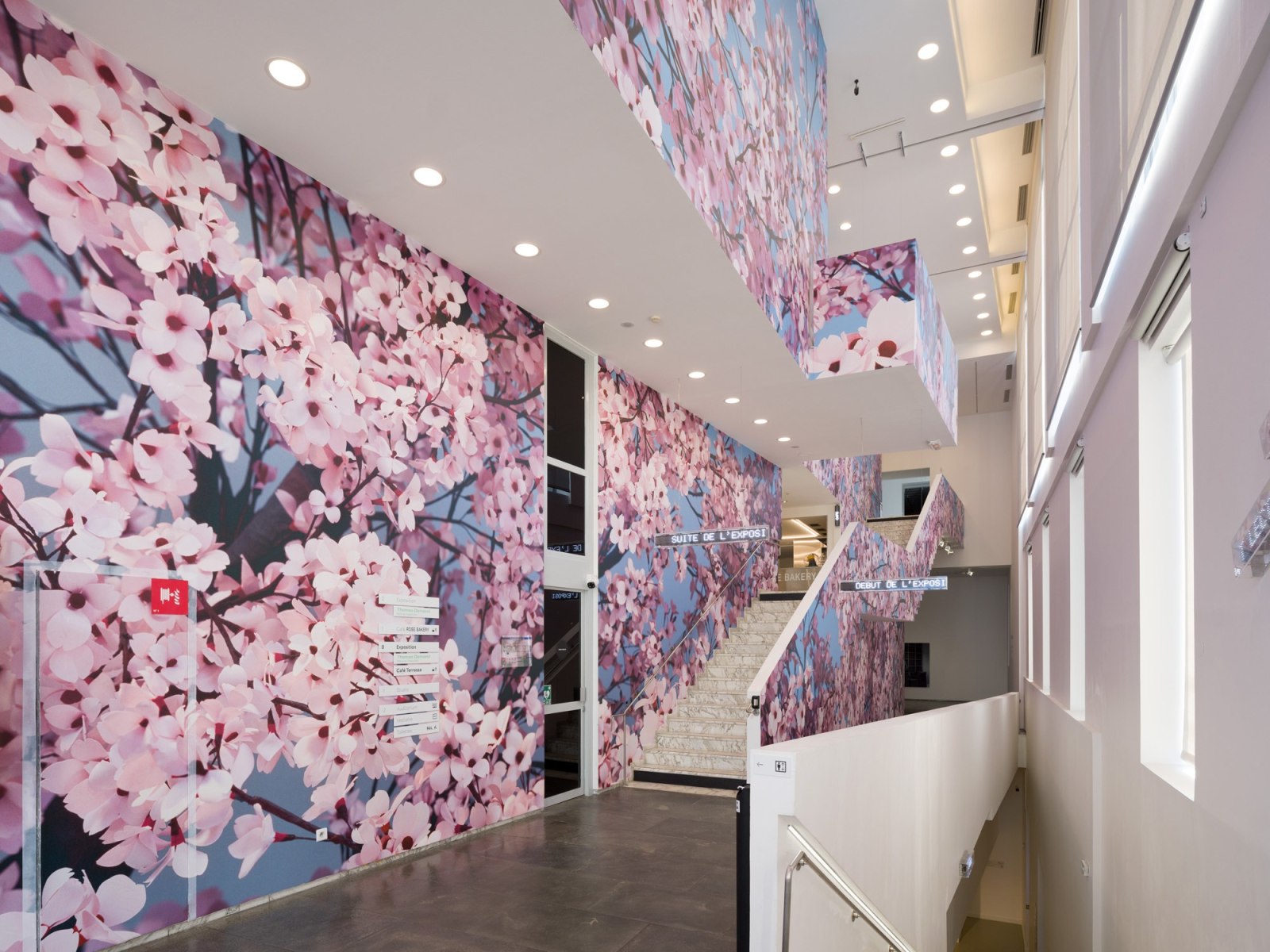
| Exhibition view: Thomas Demand, The Stutter of History, Jeu de Paume, Paris, 2023. © the artist / VG Bild-Kunst, Bonn, 2023.
Photo © Jeu de Paume / François Lauginie | |
|
The Stutter of History will tour to the Israel Museum, Jerusalem, August 1, 2023 – January 1 2024; Museum of Fine Arts, Houston, June 16 – September 5, 2024; Taipei Fine Arts Museum, Taipei, November 30 2024 – March 9, 2025. The tour began at UCCA Edge, Shanghai in 2022.
The Jeu de Paume presents, in partnership with SNCF – Gares & Connexions, an exhibition of Dailies by Thomas Demand on the forecourt of the Gare de Lyon in Paris, concurrently to the exhibition at Jeu de Paume.
|
|
|

| Exhibition views: Thomas Demand, Dailies, Gare de Lyon, Paris, 2023. © the artist / VG Bild-Kunst, Bonn, 2023.
Photos © Studio Thomas Demand | |
|
Formes et Patrons d’Azzedine Alaïa par Thomas Demand
Forms and Patterns of Azzedine Alaïa by Thomas Demand
|
|
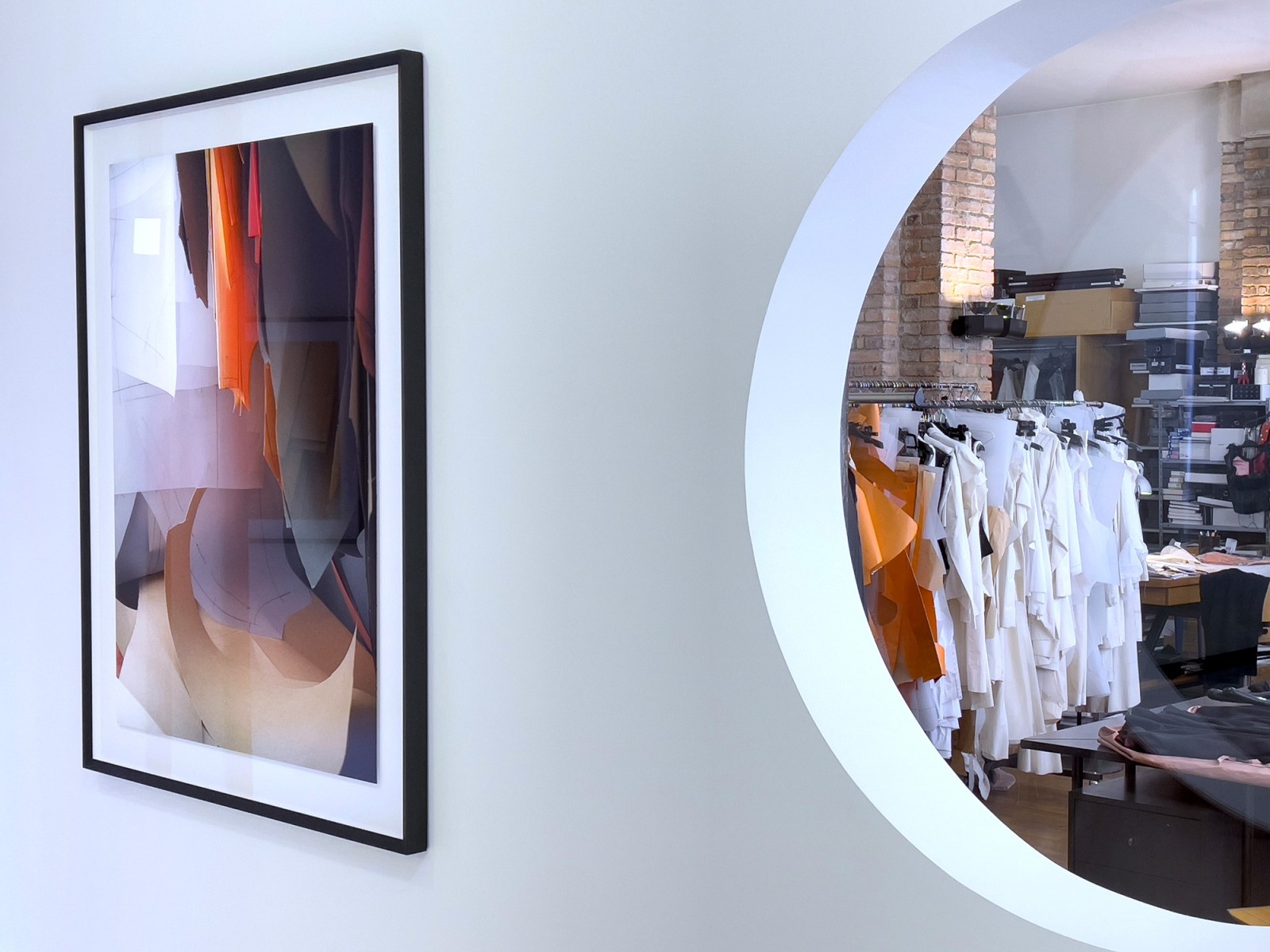
| Exhibition view: Formes et Patrons d’Azzedine Alaïa par Thomas Demand (Forms and Patterns of Azzedine Alaïa by Thomas Demand), Fondation Azzedine Alaïa, Paris, 2023. © the artist / VG Bild-Kunst, Bonn, 2023. Photo © Sylvie Deplech / Fondation Azzedine Alaïa | |
|
In March 2022 Thomas Demand told Artforum's Lucas Matheson how the series of photographs of Azzedine Alaïs pattern came about. These are excerpts from Demand's text.
"After Azzedine Alaïa passed away in 2017, his foundation invited me to come and photograph his desk. That wasn’t really for me. I thought I wouldn’t do it justice, as I couldn’t add anything to what was there already. But I saw these patterns hanging around. I had been looking at patterns of clothing for a long time, as well as clothing workshops where they have these patterns hanging, especially in leather fabrication. They remind me of Duchamp’s rulers in Three Standard Stoppages, the accidental curve. So these curving patterns in Alaïa’s workshop function as a kind of ruler for their clothing. It’s very abstract. You don’t see a T-shirt there or a dress or jacket, but you see the elements.
A special thing with Alaïa was that he made all his patterns himself. He would make a pattern with a model and cut them and then a member of his workshop would translate them to different sizes. But the first pattern of the jacket he would do himself, and he would construct the first items of clothing. It would always be very muted, black, maybe red or with a little bit of pattern, but ultimately it wouldn’t be about patterns or color, it would always be about material and how a piece of clothing can be constructed. In that sense it’s very architectural. The potential of this clothing was very intriguing to me. [...] |
|
|
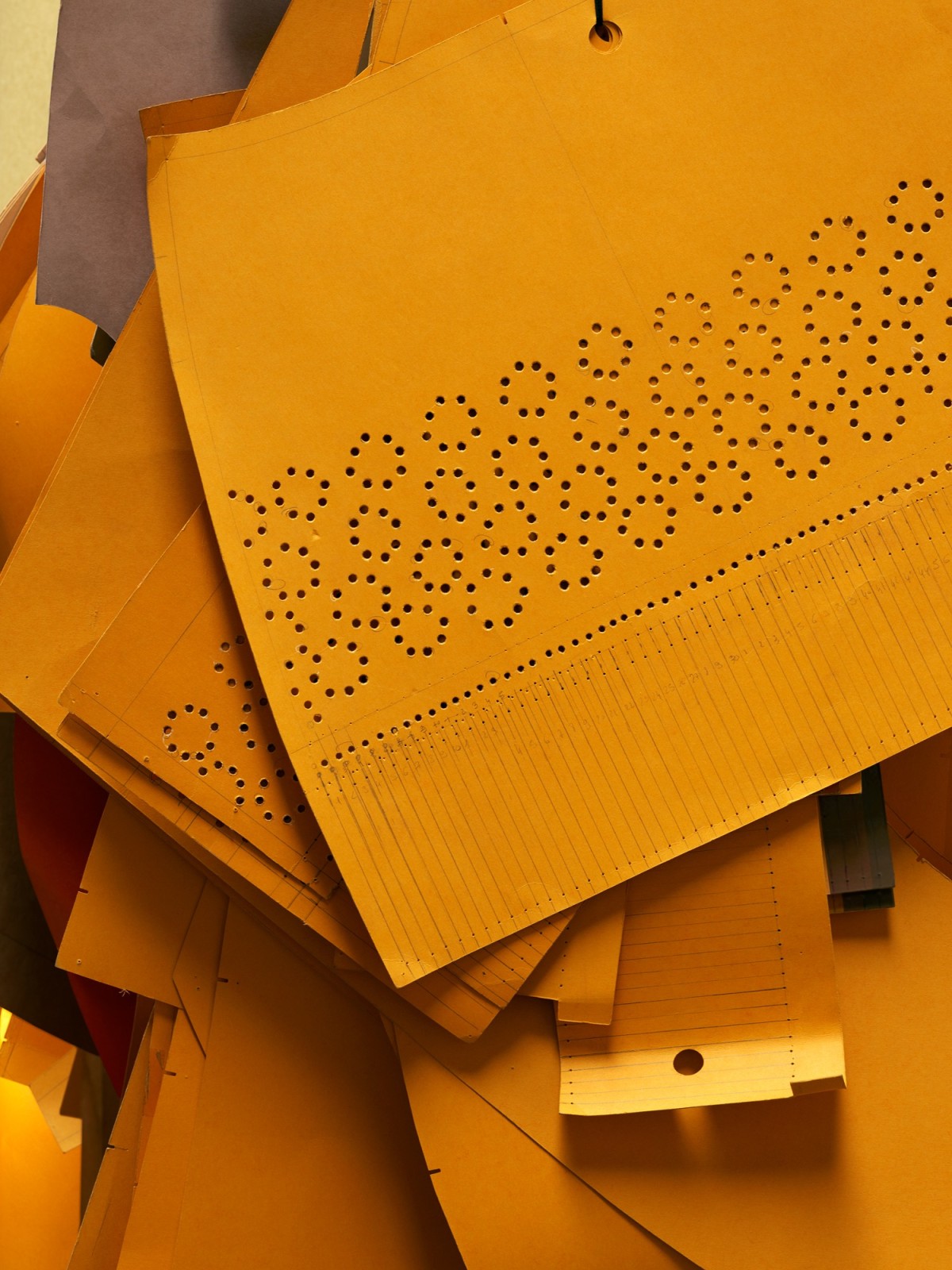
|
Thomas Demand, oriole, 2021, pigment print, framed. 122.5 x 98 cm. © the artist / VG Bild-Kunst, Bonn, 2023
| |
|
[...] What my photographs of interiors all have in common is a certain presence. The feeling that someone has just left the room, or that somebody will come back around the corner in a second. Like when you go in a shop and there’s nobody there, you think, “I could take everything I want.”There’s a kind of fragility to the moment. At the core of this is the observation that if you have a photograph of any space, and you have two people in the photograph,it’s all about these two people in the space. If you have a photograph of the same space without the people, it’s about you occupying the space, your mind, your brain,you yourself imagining what it’s like to be there. With these newer photographs, there’s the presence of Alaïa. He’s very present in the cutouts and the drawings and every mark on the objects. But at the same time, the intention of these shapes is absent. I wouldn’t say you can see an arm in it or something. But you can see a bit of progress, a purposefulness. You can tell that these are not shapes to build a house. They’re not shapes to become a chair. I think people immediately understand that this is not the technical drawing of an architect, because of its fluidity. There’s a sense that everything is a pattern for something bigger to come." The full text can be found HERE.
|
|
|

| Exhibition view: Formes et Patrons d’Azzedine Alaïa par Thomas Demand (Forms and Patterns of Azzedine Alaïa by Thomas Demand), Fondation Azzedine Alaïa, Paris, 2023. © the artist / VG Bild-Kunst, Bonn, 2023. Photo © Sylvie Deplech / Fondation Azzedine Alaïa | |
|

| Exhibition view: Ends of Research. Stefan Bertalan, Esther Schipper, Berlin, 2023. Photo © Andrea Rossetti
| |
|
"Since I was a child I was Daphnis in love with Chloe, who was Nature-cow-chicken; Chloe, who was Karin carithabilis. (...) All these swarm (like a cosmic circumvallation) in my body. Therefore I'm not finished, I'm not dead - instead I'm a newborn: right now I get down from my mother's bed. I make the first steps in the yard - I start knowing..."—Stefan Bertalan
Yesterday Ends of Research. Stefan Bertalan openend in Berlin. The exhibition includes over 50 works on paper spanning from the 1960s through the 2000s, selected by the Romanian art historian Erwin Kessler, an authority on Bertalan’s work.
Stefan Bertalan (1930-2014) was the main figure of research-based, process-oriented and innovation-driven art in Romania. In 1966 he founded the experimental neo-constructivist group 111, with Roman Cotoșman and Constantin Flondor. After the defection of Roman Cotoșman, another group, Sigma (1969-1982), was founded. Bertalan was a driving force both of 111 and Sigma. For decades, the two groups were the most influential, innovative art groups in Romania and shaped the artistic, educational and curatorial practices of generations of young artists and theorists.
Bertalan worked in many media, producing drawings, photographs, installations, actions, environments and happenings, often with innovative materials such as plastics, natural and synthetic fibers, X-ray photos, aluminum. However, nearly ninety percent of his output are works on paper. This is the focus of Ends of Research. Stefan Bertalan
|
|
|
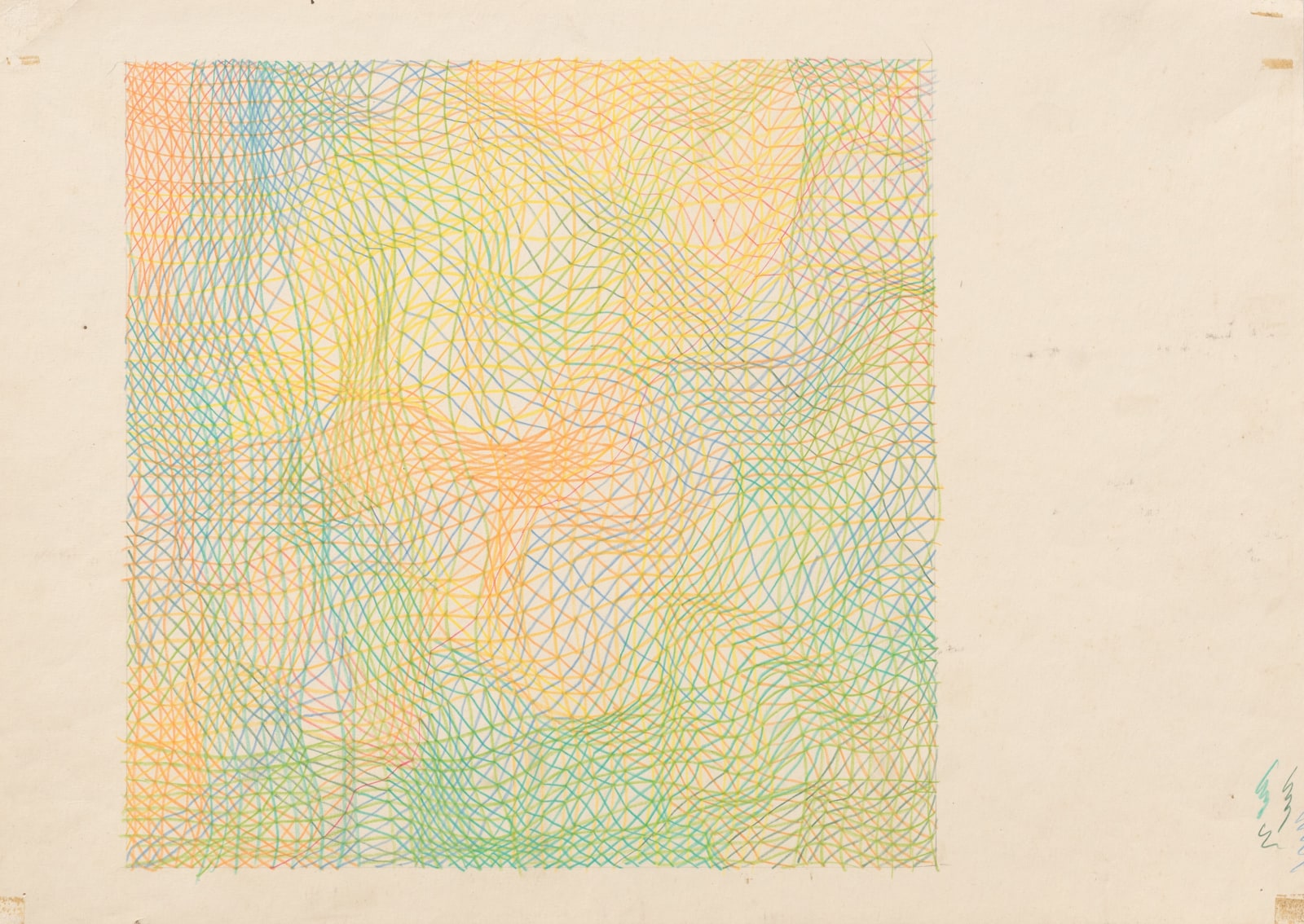
| Exhibition view: Ends of Research. Stefan Bertalan, Esther Schipper, Berlin, 2023. Photo © Andrea Rossettin | |
|
The carefully selected works exhibited in Ends of Research are taken from different series across Bertalan’s entire career. Together they also tell a story. They display the discontinuities but also the striking continuum of a career balanced between the earlier ends of his scientific-like research (the geometric, abstract perfection of shapes and objects), and the later ends of his psycho-political, manic research in which he projected himself (as self-portrait) into the biological-cosmic-fantastic world around him. Ends of Research shows how the research of abstract structures slowly opens towards the figures of the outer world and subsequently unfold into research of his own human traits, which then develop into research of his body, but one whose anatomy progresses into geology and cosmology.
|
|
|

| Exhibition view: Ends of Research. Stefan Bertalan, Esther Schipper, Berlin, 2023. Photo © Andrea Rossetti | |
|
Ends of Research is an introduction to Bertalan’s enthralling, creative research process, and his (mystical) ecology and blistering political criticism. The exhibition unveils utopian and modernist ambitions and paradoxes, the limits of reason, the perpetual, inner and outer emigration, the status of the artist as a risky, fragile researcher of the absolute perfection, and the weird workings of an indomitable, critical consciousness preying on itself until the very last moments of life. It simultaneously points to the political and ethical issues raised by repression, age, and illness. Bertalan is a paragon of the emerging concerns of sustainability and conservation both in society and art. His profuse and ecstatic work foreshadowed the contemporary focus on an holistic consciousness of the nature and the human.
Erwin Kessler
|
|
|
Karolina Jabłońska, Tomasz Kręcicki, Cyryl Polaczek
|
|
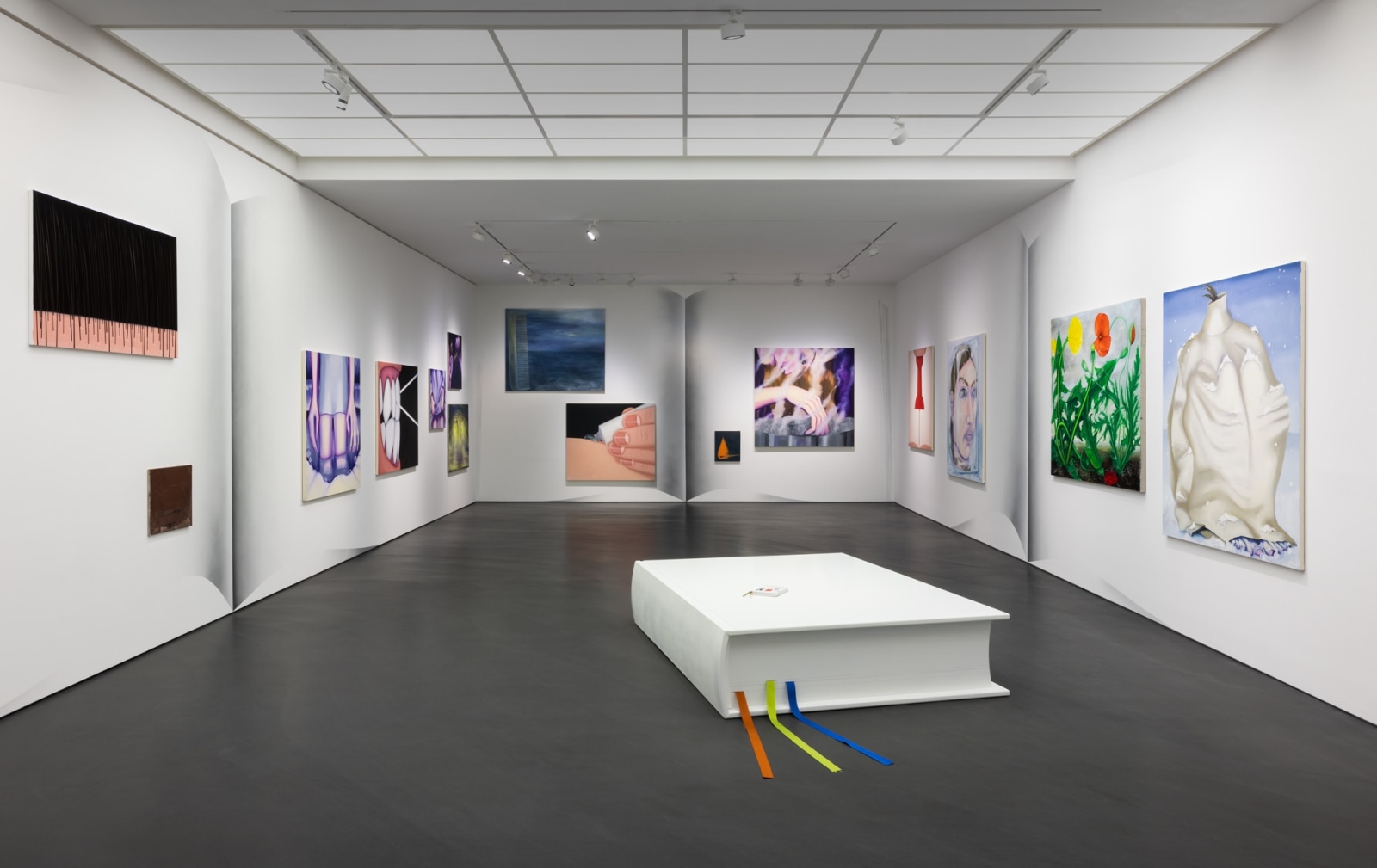
| Exhibition views: Karolina Jabłońska, Tomasz Kręcicki, Cyryl Polaczek, Reconciling Apparent Contradictions, Esther Schipper, Berlin, 2023. Photos © Andrea Rossetti
| |
|
The three young Polish artists Karolina Jabłońska, Tomasz Kręcicki and Cyryl Polaczek—all in their early 30s—began to work collaboratively under the name Potencja in 2012, while working towards their diplomas at the Fine Arts Academy in Kraków. Potencja has exhibited together—and apart—and operated an independent art space by that name. Characterized by a sense of the absurd, playing with extreme scale and distinct color palettes, their paintings take everyday life experiences as subjects, with frequent nods to art historical references, and riff off each other in a close artistic dialogue. At the same time, each artist has developed their own formal vocabulary.
Installed on a painted background made to resemble pages of an open book, Reconciling Apparent Contradictions plays with the idea of what an exhibition of paintings may look like. The works by the three artists are mixed and placed as if illustrations on a page. At the same time, the setting—and the monumentally-scaled book in the center of the room—are references to their recent publication Potency. A Glossary of Symbols. Published to accompany their exhibition at BWA Zielona Góra in 2021, the book tells a tall tale of the founding of their group, taking a mock mythologizing tone to playfully introduce their respective painting practices and symbolism of (shared) motifs. This mixture of self-seriousness and mockery is characteristic of their practices and equally evident in the paintings on view.
|
|
|
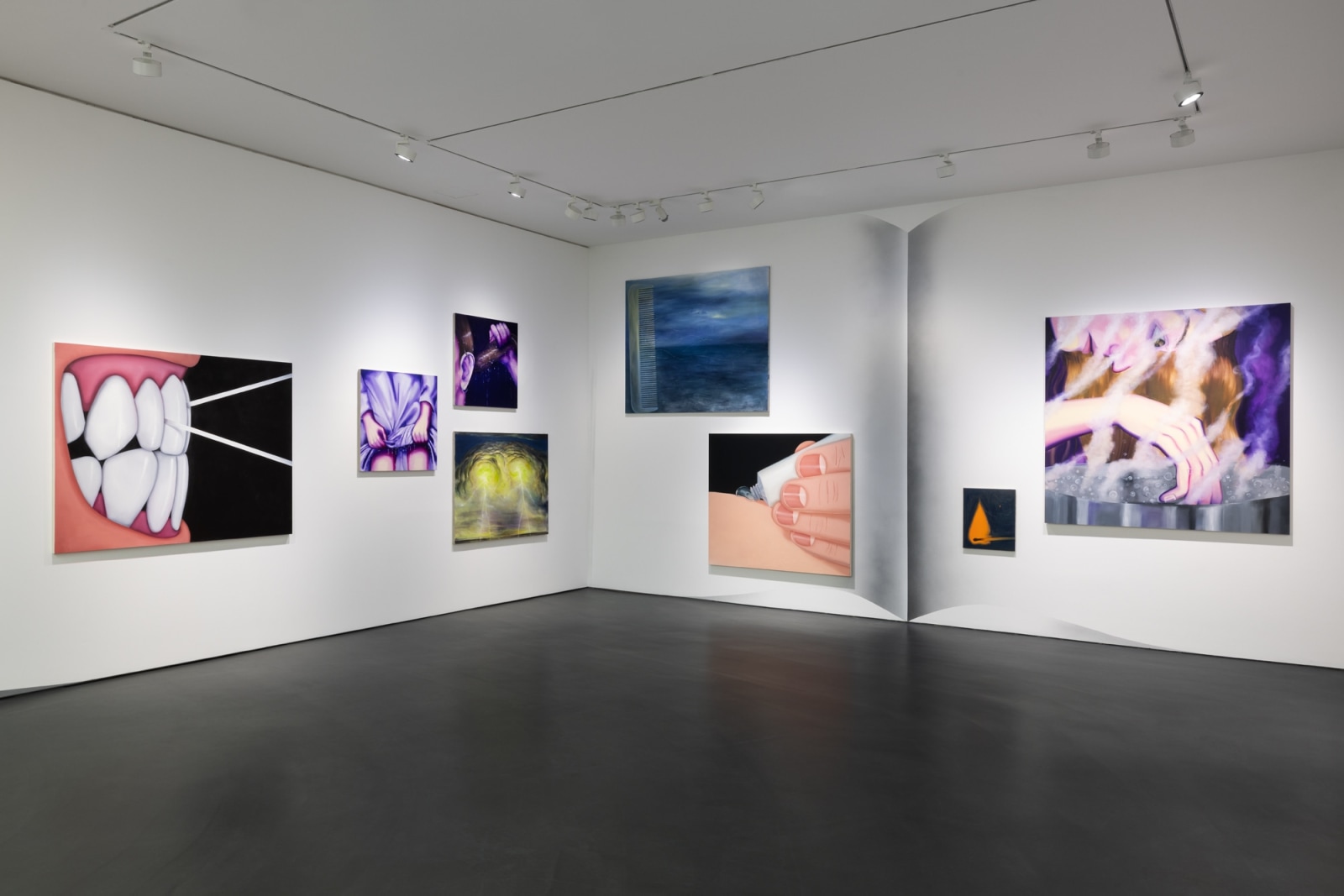
| Exhibition views: Karolina Jabłońska, Tomasz Kręcicki, Cyryl Polaczek, Reconciling Apparent Contradictions, Esther Schipper, Berlin, 2023. Photo © Andrea Rossetti
| |
|
Karolina Jabłońska’s paintings in this exhibition have a distinct palette. Her purplish depictions of face —generally self-portraits—suggest strong emotions but also evoke a visceral response in the viewer. We feel the freezing cold, even if her pictorial alter ego, standing in a frozen lake or with her head encased in a giant ice cube, appears not to mind. Deeply felt and keenly observed, her works capture the awkwardness of certain everyday activities, be it washing your hair, wringing out a wet dress or boiling water. As the artist has put it, “the paintings come from small sensory and emotional impressions.” Yet, the personal is also political: metaphors for emotional states, inherent in these paintings are references to the role of women, the existential threat to their bodies and restrictions imposed by political realities.
|
|
|
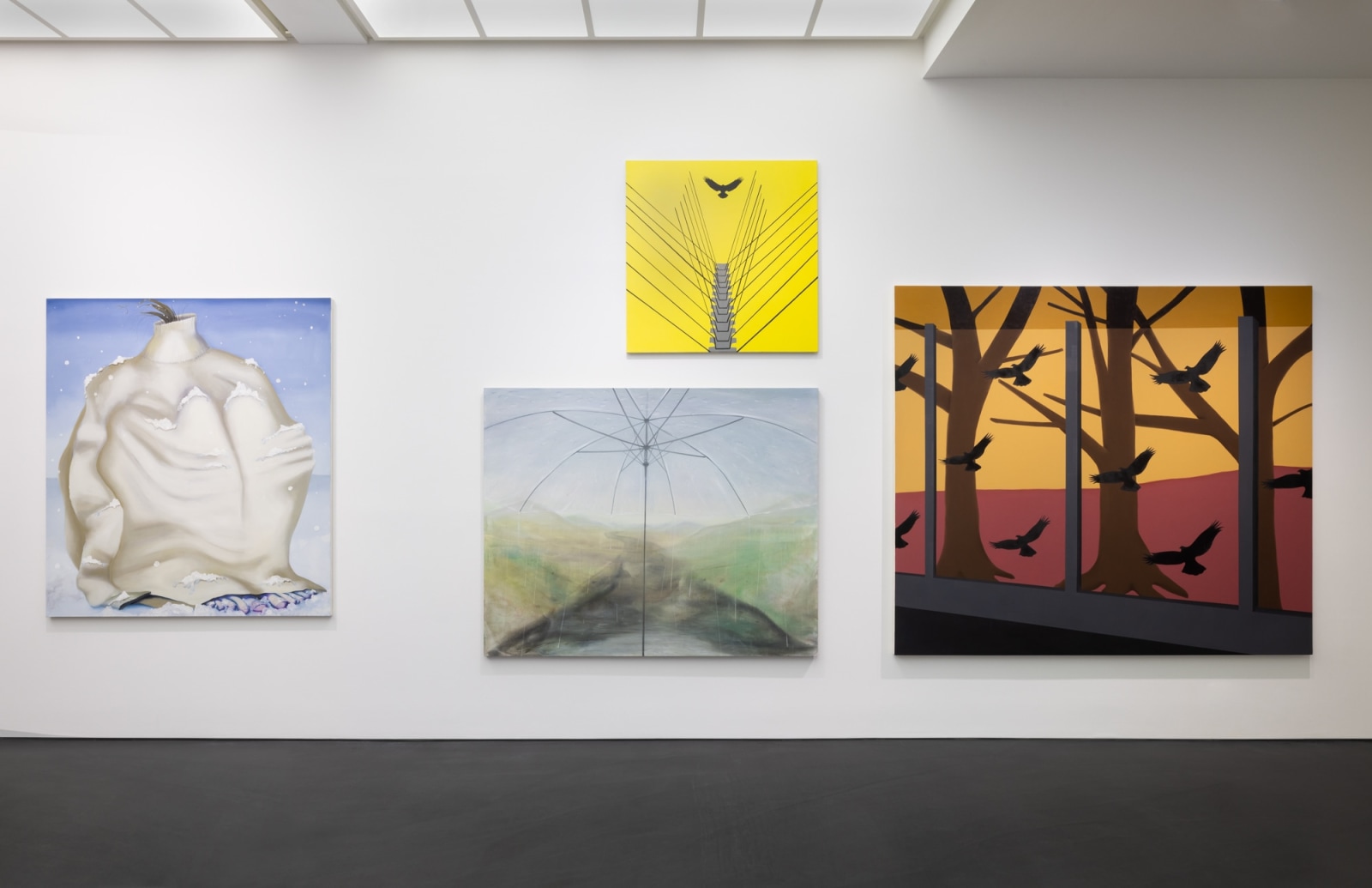
| Exhibition views: Karolina Jabłońska, Tomasz Kręcicki, Cyryl Polaczek, Reconciling Apparent Contradictions, Esther Schipper, Berlin, 2023. Photo © Andrea Rossetti
| |
|
Scale and the body are also major motifs in the paintings of Tomasz Kręcicki. Grotesquely enlarged fingers applying gelatinous substances from an unmarked tube have an absurdist element but also evoke the artist’s continued exploration of the abstract in figuration. A surrealist unreality imbues the artist’s depictions of common activities and everyday objects, recalling a Lynchian atmosphere but often cut with a dash of the campy spookiness of B-movie horror. Yet, the recurrence of fingers, hands and eyes, also refers to a painter’s tools. A major theme has been a kind of bathos: the mockery of earnestness, undercutting aspirations through absurdity, jokes, and wit. At the same time, works such as Bird, 2023, or Needles, 2022, evoke a sense of anxiety and foreboding created by the implied physical threat of a pushpin poised to break the skin or pattern of long black wires used to deter birds. Kręcicki’s subject matter then is inherently existential and addresses both contemporary politics and its repercussions on the individual.
|
|
|
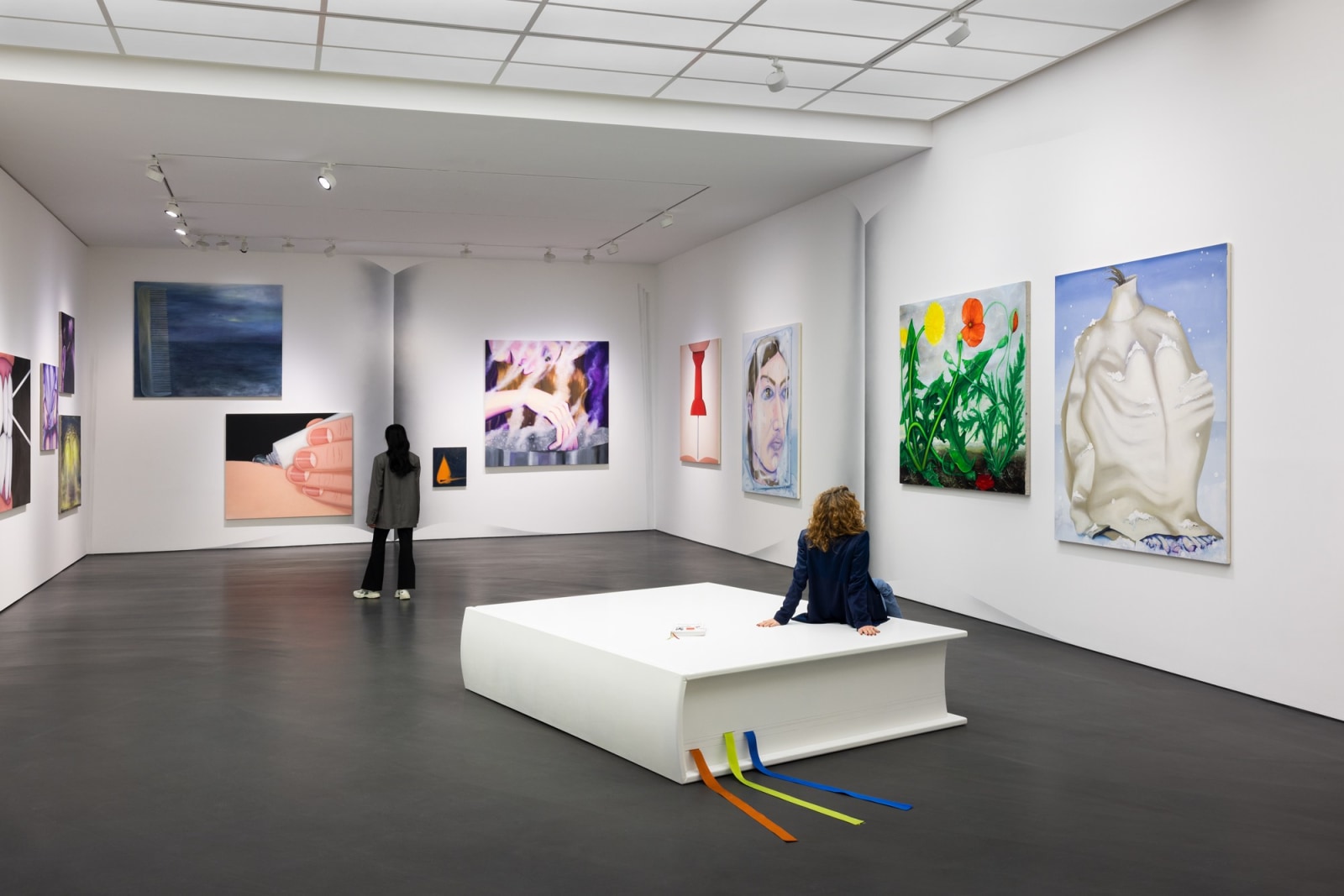
| Exhibition view: Karolina Jabłońska, Tomasz Kręcicki, Cyryl Polaczek, Reconciling Apparent Contradictions, Esther Schipper, Berlin, 2023. Photo © Andrea Rossetti
| |
|
Oscillating between the natural and the everyday—sometimes in the same work—Cyryl Polaczek imagery can have a rebus-like and/or narrative quality that conjures up a story or, in its incongruity, provokes puzzlement: what are we to make of the comb hovering over a brooding seascape, cloverleaves in a wallet or a hand holding an oyster with its pearl? Often the spectator is part of the scene, as in Rain, 2023, walking in a rainy landscape and apparently looking through a transparent umbrella at either a path or a river as water drips down all around us. Polaczek, as do Karolina Jabłońska and Tomasz Kręcicki, uses scale in a deliberate often funny manner. Skillfully painted, the artist’s works vary in technique. Paintings such as Pearl and Wallet, both 2023, use thick layers of paint almost in a sculptural way to create surfaces outlining depicted objects. Another series of recent works, the seascape and rainy scene mentioned above and a dramatic painting of storm clouds, are painted in thin washes with loose brushstrokes, on the brink of dissolving the contours of its motifs.
|
|
|
My father, mon père, mein Vater.
Edited by Jeanne Tremsal. |
|
 | Special presentation around Jeanne Tremsal's new book 'My father, mon père, mein Vater’, Esther Schipper Bookstore, Berlin, 2023. Photos © Andrea Rossetti
| |
|
The book 'My father, mon père, mein Vater' emerged from the legendary exhibition 'My father, my neighbors, my friends and their friends'. Legendary because almost no one could see it. It did take place from 11 December 2020, to 14 February 2021, at the Fahrbereitschaft in Berlin Lichtenberg, but it was during the lockdown. And we were in a timelock, the artist around whom the exhibition was built, Benoît Tremsal (the father), was seriously ill. So there was a long video conversation with some of the artists and Jeanne (the daughter) and Benoît Tremsal, which is in English and French and forms the core of the book. Writing about the exhibition for the Frankfurter Allgemeine Sonntagszeitung, Niklas Maak called Benoît Tremsal "one of the most interesting French artists of Land Art." The book also contains a much too long footnote about Martin Heidegger's notorious SPIEGEL conversation and, of course, photographs of the exhibition.
Participating artists: Albert Oehlen, Angela Bulloch, Aylin Langreuter, Benoît Tremsal, Björn Dahlem, Christopher Roth*, Constanze Haas, Cosima von Bonin, Isa Melsheimer, Joel Tauber, Lisa Seebach, Manfred Holtfrerich, Manfred Pernice, Paul Hance, Reena Saini Kallat, Roman Moriceau, and terra0.
*presents: Anne Tismer, Dieter Meier, Joseph Beuys, Lothar Baumgarten, Marcus Coates and Paul Klee
Publisher, Sorry Press
Edited by Jeanne Tremsal
Design Wiegand von Hartmann
112 pages, stamped and numbered
ISBN978-3-9820440-8-8 |
|
|
Stefan Bertalan
Inner emigration
Erwin Kessler, 2016
Publisher: Editura Vellant
Languages: English, Romanian
Available here
|
|
Thomas Demand / Hal Foster
Thomas Demand – The Dailies (Expanded Edition)
2023
Publisher: MACK
Language: English
Available here
|
|
Thomas Demand
The Stutter of History
2022
Publisher: MACK
Language: English
Available here
|
| |
|
POTENCJA GLOSSARY OF SYMBOLS
Łukasz Zawada, 2021
Publisher: BWA Zielona Góra
Language: Polish, English
Available here
|
|
Karolina Jabłońska
MADE–UP STORY
Soren Gauger, Alison M Ginger's, Karolina Jabłońska, Mary Szydłowska, 2022
Publisher: Fundacja Raster, Warsaw
Languages: Polish, English
Available here
|
|
TOMASZ KRĘCICKI WIEŻE CIŚNIEŃ / WATER TOWERS
Aldona Kopkiewicz, 2020
Publisher: Stereo
Languages: Polish, English
Available here
|
|
Tomasz Kręcicki - The Book
Karolina Jabłońska, Tomasz Kręcicki, Cyryl Polaczek, Radek Szlęzak, Wojciech Szymański, Łukasz Zawada, 2019
Publisher: Biuro Wystaw Artystycznych w Tarnowie
Languages: Polish, English
Available here
|
|
My father, mon père, mein Vater
Jeanne Tremsal, 2023
Publisher: Sorry Press
Language: English
Available here
|
|
|
ESTHER SCHIPPER
POTSDAMER STRASSE 81E
10785 BERLIN
|
|
|
|
|
